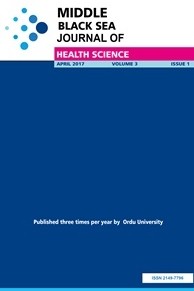Assessment of Unavoidable Corrosive Substance Ingestion in Children
Objective: Corrosive substances are agents which ease our lives, but they can also make children’s’ lives completely difficult as a result of contact with gastrointestinal tract, respiratory tract and skin. Examinations and treatments of patients hospitalized in our clinic with the complaint of corrosive substance ingestion were examined. Methods: The records of 45 patients who were hospitalized in our clinic between May 2017 and December 2018 were examined retrospectively. The patients’ ages, genders, ingested corrosive substance, admission and discharge inflammatory markers were examined according to diagnosis and treatment type. Results: Of the 45 cases, 24 (53,3%) were male, while 21 (46,7%) were female. The youngest case was 9 months old, the oldest case was 168 months and average age of the cases was 24,7 months. The substances the cases were exposed to were bleacher in 20 patients (44,4%), dishwasher detergent in 11 patients (24,4%), rinse aid in 5 patients (11,1%), drain cleaner in 4 patients (8,9%), washing machine detergent in 3 patients (6,7%), decalcifier in 1 patient (2,2%) and surface cleaner (sodium hypochlorite) in 1 patient (2,2%). Endoscopy was performed on two patients with clinical symptoms who ingested drain cleaner. Statistically significant difference was found between the hospitalization and discharge white blood cell count×103/uL (WBC), lymphocyte count×103/Ul (LYM), platelet count ×103/uL (PLT), red blood cell width (RDW,%), mean platelet volume (MPV), neutrophil/lymphocyte ratio (NLR), platelet/lymphocyte ratio (PLR) values of the patients (p<0.05). Conclusion: With precautions taken to prevent the ingestion of corrosive substances, a significant cause of morbidity and mortality can be prevented significantly. It is important to raise awareness in families on this issue.
Keywords:
Child corrosive substances, esophageal stricture,
___
- Aksu B, Inan M. Corrosive Burns of the Esophagus in Children. Medical Journal of Trakya University 2002;19:183-8.
- Anderson KD, Rouse TM, Randolph JG. A controlled trial of corticosteroids in children with corrosive injury of the esophagus. N Engl J Med. 1990;323:637-40. https://doi.org/10.1056/NEJM199009063231004
- Ashcraft KW, Padula RT. The effect of dilute corrosives on the esophagus. Pediatrics. 1974;53(2):226-32.
- Atabek C, Surer I, Demirbag S, Caliskan B, Ozturk H, Cetinkursun S. Increasing tendency in caustic esophageal burns and long-term polytetrafluorethylene stenting in severe cases: 10 years experience. Journal of Pediatric Surgery. 2007;42(4):636-40.
- Berthet B, Costanzo J, Arnaud C, Choux R, Assadourian R. Influence of epidermal growth factor and interferon G on healing of oesophageal burns in the rat. Britsh J Surg 1994; 81:395-8.
- Cankorkmaz L, Koyluoglu G, Guney C. Children with corrosive esophageal burns and esophagoscopy. Journal of Pediatric Surgery 2009;23(3):110-3.
- Fulton JA, Hoffman RS. Steroids in second degree caustic burns of the esophagus: a systematic pooled analysis of fifty years of human data: 1956-2006. Clin Toxicol (Phila) 2007;45:402-8.
- Gaudrealt P, Parent M, Guigan MA, et al. Predictability of esophageal ınjury from sign and symptoms: study of caustic ingestion in 378 children. Pediatrics 1983; 71:767-770.
- Genç A, Mutaf O. Esophageal Motility Changes In Acute And Late Periods Of Caustic Esophageal Burns And Their Relation To Prognosis In Children. Journal of Pediatric Surgery. 2002;37:1526-28.
- Hawkins DB, Demeter MJ, Barnett TE. Caustic ingestion: controversies in management: A review of 214 cases. Laryngoscope. 1980;90:98-100.
- Hugh T.B, Kelly M.D. Corrosive ingestion and the surgeon. J Am Coll Surg1999;189:508-22.
- Jelenko C, 3rd, Story J, Ellison RG, Jr. Ingestion of mineral acid. Am Surg. 1974;40(2):97-104.
- Kasap E, Ozutemiz A. Danger in pet bottle: Corrosive esophagitis. Current Gastroenterology 2006;10:29-35.
- Kayaalp L, Odabaşı G, Doğangün B, et al. Corrosive esophagitis in children: sociel and psychological aspects. Türk Pediatri Arşivi 2006; 41:24-30.
- Nicosia JF, Thornton JP, Folk FA, Saletta JD. Surgical mana- 188 İzmir Dr. Behçet Uz Çocuk Hast. Dergisi 2018;8(3):184-188 gement of corrosive gastric injuries. Annals of Surgery. 1974;180(2):139-43.
- Nuutinen M, Uhari M, Karvali T, et al. Consequences of caustic ingestions in children. Acta Paediatri 1994; 83:1200-1205.
- Oldham KT, Colombani PM, Foglia RP, Skinner MA (eds). Priciples and practise of pediatric surgery. Philadelphia: Lippincott Williams & Wilkins; 2005. 1023-39.
- Ozguner IF, Savas C, Yavuz MS, Kaya SA, Buyukyavuz BI. The Accıdental Caustıc Esophagıtıs in Children. SDU Medical Faculty Journal. 2002;9(3).
- Previtera C, Giusti F, Guglielmi M. Predictive value of visible lesions in suspected caustic ingestion: may endoscopy reasonably be omitted in completely negative pediatric patient ? Pediatr Emerg Care 1990; 6:176-178.
- Rama BR, Robert SF. Caustics and Batteries. In Goldfrank’s Toxicologic Emergencies, 4th Ed (Eds Goldfrank LR et al.): Connecticut, Appleton-Lange. 1998; 1399-1424.
- Romanczuk W, Ryszard K. The significance of early panendoscopy in caustic ingestion in children. Turk J Pediatr 1992; 34:93-98.
- Roy CC, Silverman A, Alagille D. Esophageal burns and foreign bodies. Pediatric Clinical Gastroenterology. Mosy Year Book Inc. St Louis. 1995:153- 158.
- Sumeli R. The efficiency of Hypericum perforatum oily in treatment of corrosive esophageal. Trabzon: Karadeniz Technical University Faculty of Medicine, Medical specialty thesis. 2018.
- Wasserman RL, Ginsburg CM. Caustic substanse injuries. J Pediatr. 1985; 107:169-174.
- Yayın Aralığı: Yılda 4 Sayı
- Başlangıç: 2015
- Yayıncı: Ordu Üniversitesi
